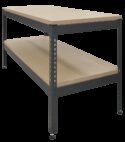Experiment
EC1500V

REFRIGERATION CYCLE
Bench-top unit that allows students to investigate the stages of refrigeration.
If you have any questions or you'd like to discuss a product, please call us.
+44 1159 722 611REFRIGERATION CYCLE
This simple refrigeration cycle unit assists students to learn the stages of refrigeration at an entry level. Students learn about Pressure-Enthalpy charts and use them to determine the Coefficient of Performance (COP), superheat and sub-cooling from the enthalpy changes.
The refrigeration circuit features high and low pressure gauges, a pressure switch, sight glass, filter dryer and TEV valve. The circuit also includes pressure transducers that connect to the instrumentation.
The evaporator and condenser coils are submerged in heat source and heat sink water tanks for the clear demonstration of a practical heat pump. A small pump provides a circulation of the water between the heat source and sink for steady state experiments.
Learning outcomes
- Learn to use a P-h Chart
- Determine Coefficient of Performance (COP)
- Determine superheat and sub-cooling
- Basic refrigeration cycle energy balance
- Determine isentropic and non-isentropic efficiencies of the compression stage
- Effect of heat source and heat sink temperatures on COP









